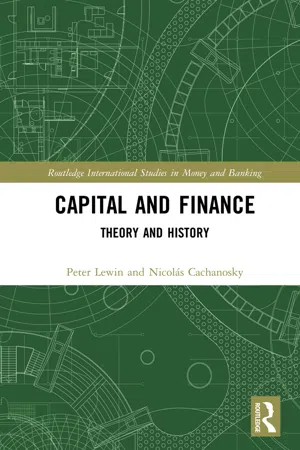
- 150 pages
- English
- ePUB (mobile friendly)
- Available on iOS & Android
About This Book
This book applies finance to the field of capital theory. While financial economics is a well-established field of study, the specific application of finance to capital theory remains unexplored. It is the first book to comprehensively study this financial application, which also includes modern financial tools such as Economic Value Added (EVA®).
A financial application to the problem of the average period of production includes two discussions that unfold naturally from this application. The first one relates to the dual meaning of capital, one as a monetary fund and the other one as physical (capital) goods. The second concerns its implications for business-cycle theories. This second topic (1) provides a solid financial microeconomic foundation for business cycles and, also (2) makes it easy to compare different business-cycle theories across the average period of production dimension. By clarifying the obscure concept of average period of production, the authors make it easier to analyze the similarities with and differences from other business-cycle theories.
By connecting finance with capital theory, they provide a new point of view and analysis of the long-standing problems in capital theory as well as other related topics such as the use of neoclassical production functions and theorizing about business cycles. Finally, they emphasize that the relevance of their application rests on both its policy implications and its contributions to contemporary economic theory.
Frequently asked questions
Information
Capital (I am not the first to discover) is a very large subject, with many aspects; wherever one starts, it is hard to bring more than a few of them into view. It is just as if one were making pictures of a building; though it is the same building, it looks quite different from different angles. As I now realize, I have been walking round my subject, taking different views of it.(Hicks, 1973a, p. v)
Chapter 1
Capital, income, and the time-value of money
Capital and income
Ideas matter
Assets and liabilities, income, and expenditure
Capital is the sum of the money equivalent of all assets minus the sum of the money equivalent of all liabilities as dedicated at a definite date to the conduct of the operations of a definite business unit. It does not matter in what these assets may consist, whether they are pieces of land, buildings, equipment, tools, goods of any kind, and order, claims, receivables, cash, or whatever.(Mises, 1949, p. 262, italics added. See also Braun [2017], and Braun, Lewin, and Cachanosky [2016])
Table of contents
- Cover
- Half Title
- Series Information
- Title Page
- Copyright Page
- Table of Contents
- List of Figures
- List of Tables
- Preface
- Introduction
- Part I Capital, production, and time
- Part II History of capital theory
- Part III Financial applications
- References
- Index